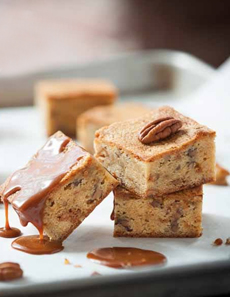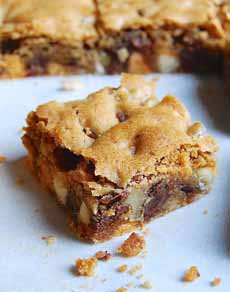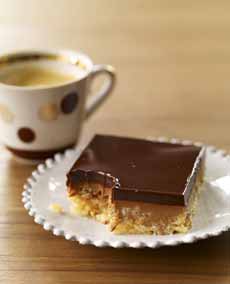FOOD HOLIDAY: The History Of Blondies For National Blondie Day
|
January 22nd is National Blondie Day, a confection also called blond brownies and butterscotch brownies. (To add to the confusion, May 9th is National Butterscotch Brownie Day.) The shape and texture are similar to chocolate brownies, but the ingredients are different. Blondies differ from white chocolate brownies, since the latter have white chocolate in the batter. We’ve encountered some blondies with chocolate chips called Congo Bars, but accurately, Congo Bars have both chocolate chips and walnuts; coconut can be substituted the walnuts. Like brownies, blondies are bar cookies cut into rectangles or squares. They’re great as a base for a sundae, topped with butterscotch, caramel or chocolate sauce. We know the history of brownies, but where did blondies originate? Like brownies, blondies originated in the U.S. We’re just not absolutely certain of their creator. As bar cookies evolved in the late 19th century, molasses was a popular sweetener. Molasses bars were a popular treat. The first person publish a recipe for the brownies we know today was Fanny Farmer, in the 1896 edition of The Boston Cooking-School Cookbook (the history of brownies). But that recipe contained no chocolate; it was essentially what we today call a Blondie. According to Food Timeline, blonde brownies predate the chocolate version by about 10 years. Around 1896, a molasses-flavored bar cookie (no chocolate, cocoa or chocolate chips) called a brownie appeared. The name celebrated the elfin characters called Brownies, created by Palmer Cox and featured in popular books, stories, cartoons and verses of the time (the Eastman Kodak Brownie camera was also named after these elves). According to another source, in the 1906 edition of her cookbook, Farmer published an updated version of her cookbook that included a blondie recipe and a brownie recipe, both called brownies. Alas, we’ve only been able to get our hands on the 1896 version, reprinted and available on Amazon (link above), so we can’t do our own fact-checking. After the later introduction and popularity of chocolate brownies, the molasses brownies became known as blonde brownies. Subsequently, some bakers started to substitute brown sugar for the molasses, providing a butterscotch taste and a new name, butterscotch brownies. |
|
|
|
Also according to Food Timeline, the name “Blondie” surfaces in the 1980s. It was not named for Dagwood Bumstead’s wife. Although we grew up in the food wonderland that is New York City, we don’t recall seeing a blondie or a butterscotch brownie until the mid 1970s or early 1980s. Then, some time around then, an artisan bakery whose name, alas, we can’t remember (and is no longer in business) began selling packaged blondies, brownies, chocolate chip cookies and other baked beauties in small grocery stores and delis. The line was superior to anything else being sold—and we believe that they introduced New York to blondies on a commercial scale. If you’re that bakery and are reading this, tell us your name…and thanks for the memories!
|
||


